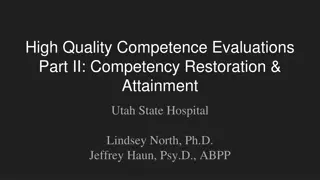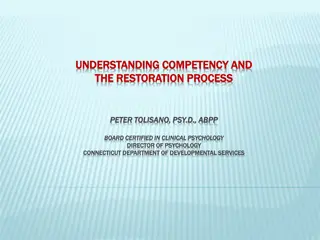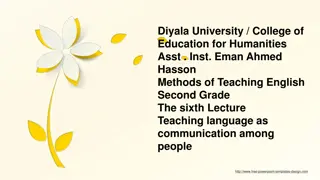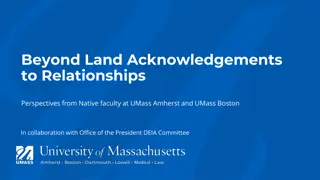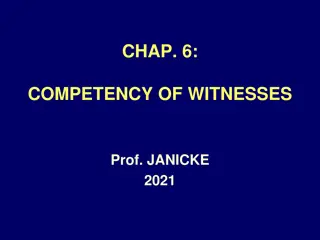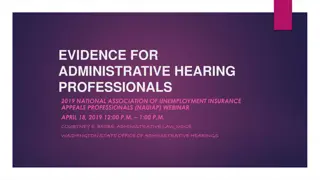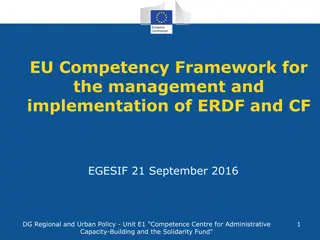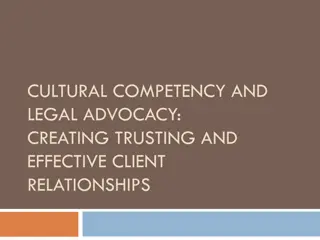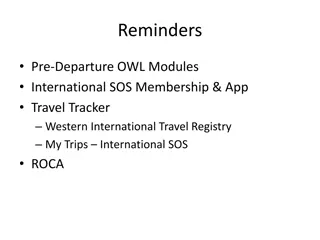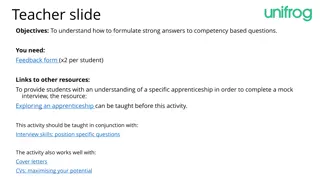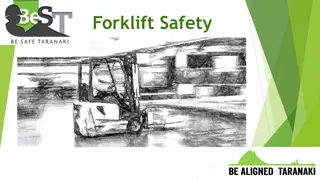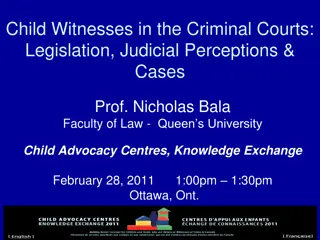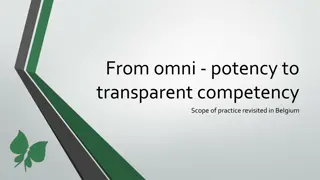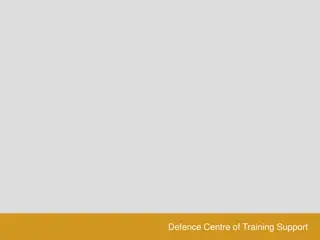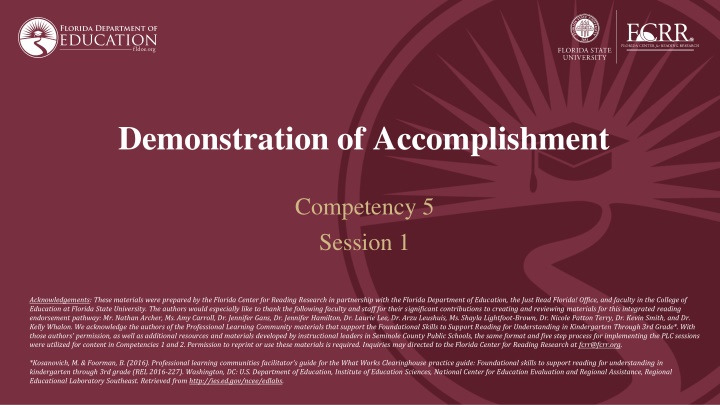
Competency 5 Session 1 Acknowledgements & Overview
Materials prepared by the Florida Center for Reading Research in collaboration with the Florida Department of Education, introductions to the course, requirements, and implementation plan for assessing reading skills.
Download Presentation

Please find below an Image/Link to download the presentation.
The content on the website is provided AS IS for your information and personal use only. It may not be sold, licensed, or shared on other websites without obtaining consent from the author. If you encounter any issues during the download, it is possible that the publisher has removed the file from their server.
You are allowed to download the files provided on this website for personal or commercial use, subject to the condition that they are used lawfully. All files are the property of their respective owners.
The content on the website is provided AS IS for your information and personal use only. It may not be sold, licensed, or shared on other websites without obtaining consent from the author.
E N D
Presentation Transcript
Demonstration of Accomplishment Competency 5 Session 1 Acknowledgements: These materials were prepared by the Florida Center for Reading Research in partnership with the Florida Department of Education, the Just Read Florida! Office, and faculty in the College of Education at Florida State University. The authors would especially like to thank the following faculty and staff for their significant contributions to creating and reviewing materials for this integrated reading endorsement pathway: Mr. Nathan Archer, Ms. Amy Carroll, Dr. Jennifer Gans, Dr. Jennifer Hamilton, Dr. Laurie Lee, Dr. Arzu Leushuis, Ms. Shayla Lightfoot-Brown, Dr. Nicole Patton Terry, Dr. Kevin Smith, and Dr. Kelly Whalon. We acknowledge the authors of the Professional Learning Community materials that support the Foundational Skills to Support Reading for Understanding in Kindergarten Through 3rd Grade*. With those authors' permission, as well as additional resources and materials developed by instructional leaders in Seminole County Public Schools, the same format and five step process for implementing the PLC sessions were utilized for content in Competencies 1 and 2. Permission to reprint or use these materials is required. Inquiries may directed to the Florida Center for Reading Research at fcrr@fcrr.org. *Kosanovich, M. & Foorman, B. (2016). Professional learning communities facilitator s guide for the What Works Clearinghouse practice guide: Foundational skills to support reading for understanding in kindergarten through 3rd grade (REL 2016-227). Washington, DC: U.S. Department of Education, Institute of Education Sciences, National Center for Education Evaluation and Regional Assistance, Regional Educational Laboratory Southeast. Retrieved from http://ies.ed.gov/ncee/edlabs.
Introductory Session Welcome
Introductory Session Overview of the Course The course is divided into 5 sessions conducted in a professional learning community format Session 1: Introductory Session Session 2: Data-Based Instruction Plan: Pre-Assessment Review & Administration Session 3: Data-Based Instruction Plan: Data Analysis Review and Plan Development Session 4: Data-Based Instruction Plan: Implementation of Plan Session 5: Data-Based Instruction Plan: Post Assessment Review & Administration Successfully completing the course satisfies the requirements of the Florida Reading Endorsement Competencies 5
Introductory Session Overview of the Course To complete the course, Participants must design and implement a classroom level progress-monitoring plan to assess all areas of reading using tools appropriate for their practicum setting (K-12). The plan will include initial assessment of the whole class and ongoing progress monitoring for students performing below expectations. Participants will identify methods to support ELLs and students with identified disabilities in their progress-monitoring plan. Using the generated data, participants will identify a target student and design individualized, supplemental lessons to address a specific reading skill. Lessons will incorporate a plan for ongoing progress monitoring and data based instructional decisions. Participants will submit a final reflection on the implementation of their plan and identify any changes they would make to support all learners including ELLs and students identified disabilities
Overview of Module 5 Sessions: Overview of Module 5 Sessions: Session 1: Introduction and MTSS Overview, RtI Overview Session 2: Data-Based Instruction Plan (DIP) : Pre-Assessment Review & Administration Session 3: Data-Based Instruction Plan: Data Analysis Review and Plan Development Session 4: Data-Based Instruction Plan: Implementation of Plan Session 5: Data-Based Instruction Plan: Post Assessment Review & Administration Review Data-Based Instructional Plan
Session 1: Multi-Tiered Systems of Support (MTSS for Reading Success MTSS)
MTSS for Reading Success MTSS for Reading Success Objectives Participants will be able to: define MTSS and RtI Models. determine the difference between MTSS and RtI Models. demonstrate their understanding of the MTSS and RtI Models by creating and presenting a visual representation of the concepts.
MTSS Pre-Assessment Please download the MTSS Pre-Assessment multiple-choice test from this google doc before we start. MTSS Pre-assessment Record your answers on your downloaded google-doc.
MTSS Lingo: MTSS- Multi-Tiered System of Support RtI- Response to Intervention PBIS- Positive Behavioral Interventions and Supports SEL- Social and Emotional Learning UDL- Universal Design for Learning
Big Picture of Big Picture of Multi-Tiered Systems of Support (MTSS) MTSS) MTSS is a framework to ensure successful education outcomes for ALL students by using a databased problem-solving process to provide and evaluate the effectiveness of multiple tiers of integrated academic, behavior, and social-emotional instruction/intervention supports matched to student need in alignment with educational standards.
MTSS has four basic components: MTSS has four basic components: 1. Multi-Tiered Levels of Prevention and Support 2. Evidence-Based Programs with High-Quality Instruction 3. Ongoing Assessment 4. Data-Based Decision Making and Problem Solving
1. Multi 1. Multi- -Tiered Levels of Prevention and Support Tiered Levels of Prevention and Support U N I V E R S A L I N S T R U C T I O N The goal of Tier 1 is to minimize instructional casualties, prevent the development of problem behaviors, and reduce the need for supports at subsequent tiers. T A R G E T E D I N T E R V E N T I O N The goal of Tier 2 is to provide additional, targeted support aligned with the Tier 1 core curriculum. Students who do not respond well are assessed for Tier 3. I N T E N S I V E I N T E R V E N T I O N The goal of Tier 3 is to help students overcome significant barriers to learning academic and/or behavioral skills required for school success. Tier 3 interventions are highly individualized to meet specific needs.
MTSS Levels of Prevention and Support Level of Support Academic (Reading) Behavioral (PBIS) High-quality, evidence-based High-quality, schoolwide learn- ing T I E R 1 core reading instruction to prevent reading environments to prevent problem behaviors UNIVERSAL INSTRUCTION problems and reduce the number of students at from occurring. risk for reading failure Supplemental, short-term, small-group Focused, frequent, small-group responses to T I E R 2 interventions to improve students specific reduce incidents of problem behaviors in TARGETED INTERVENTION reading skills situations where such incidents are likely Extremely focused, stand-alone interventions for Individualized responses to problem T I E R 3 students who continue to have acute behaviors that are resistant to or unlikely INTENSIVE INTERVENTION difficulties in reading, despite Tier 1 and Tier 2 to be addressed in Tier 1 or 2 efforts
2. Evidence 2. Evidence- -Based Programs with High Based Programs with High- -Quality Instruction Quality Instruction Academic Instruction Behavioral Instruction Components of Reading Instruction Social and Emotional Learning (SEL) Oral Language Self-Awareness Phonological Awareness Self-Management Decoding and Word Recognition Social Awareness Reading Fluency Relationship Skills Vocabulary Responsible Decision Making Comprehension Evidence-based educational programs include core curricula, interventions, practices, or policies aimed at improving student outcomes.
3. Ongoing Assessment 3. Ongoing Assessment Screening: In Tier 1 of MTSS, universal screening is used to quickly determine whether students are at risk for future academic failure or behavioral problems and may benefit from additional support Progress Monitoring is the repeated measurement of student performance. Diagnostic assessments are used to pinpoint a student s specific area of weakness. Outcome assessments are given to all students at the end of the school year. This type of summative assessment provides an indication of the overall effectiveness of the educational program, including the effectiveness of an integrated MTSS model.
4. Steps of the Problem 4. Steps of the Problem- -Solving Process Solving Process Data-based decision making involves using student assessment data and other relevant information to determine how to best enhance students academic and behavioral outcomes across all tiers of support. The decision-making process includes a problem-solving process that is also data driven.
Problem Solving Process Problem Solving Process (Define the Problem. Identify the goal) do ? (Define the Problem. Identify the goal) Problem Analysis Why is the goal not being attained? Develop Hypotheses (Root Cause Evaluate Did it work? Progress Monitor Type of Response to Instruction Modify as Necessary ) Data to verify hypotheses Implement Plan What are we going to do about it? Implement as Intended Sufficiency Implementation Support What do we want students to know and be able to
Problem Solving Step Problem Solving Step Step 1 What exactly is the problem? Is it an individual student's problem or a larger systemic problem? What specifically do we want students to know, understand, and be able to do? Step 2 Why is the problem occurring? Why are students not achieving the desired academic or behavioral outcomes? What are the barriers to the student(s) doing and knowing what is expected? Step 3 What exactly are we going to do to fix the problem? Who is responsible? What skills will be targeted? How will effectiveness be measured? How will data be collected? How will we monitor fidelity of implementation? Step 4 Is the intervention working? Is the student's response positive, questionable, or poor? What needs to be changed to better support students? Was the intervention implemented with fidelity?
T I E R 1 T I E R 2 T I E R 3 Instruction Universal Instruction Targeted Instruction Intensive Intervention Evidence-based core program implemented with fidelity Evidence-based, supplemental, short-term interventions implemented with fidelity Evidenced-based, focused, stand-alone interventions implemented with fidelity Elementary Program Secondary Elementary Secondary Students who need additional, targeted support Students who are not making adequate progress, despite Tier 1 and 2 efforts All students Learner From 90 to 120 minutes per day From 30 to 45 additional minutes per day, three-to-five times per week From 45 to 60 additional minutes per day One period per day; may replace core program Separate, one-to-one or small group (e.g., two to four students) intervention Elementary From 40 to 60 minutes per day, or one period per day Whole class plus differentiated instruction Secondary Time Small group (e.g., four to eight students) intervention Elementary Secondary Grouping Separate intervention class or period before, during, or after school Classroom teacher and/or interventionist Elementary Secondary Elementary Classroom teacher Interventionist or specialist Teac her Screening three times per year for all students; progress monitoring as needed Progress monitoring (curriculum-embedded and/or CBM) monthly or bimonthly; diagnostic assessment as needed Progress monitoring (curriculum- embedded and/or CBM) weekly or biweekly; diagnostic assessment as needed Assessment Standardized achievement tests at end of the school year; screening as needed during the year Secondary Ongoing training and support aligned with core program, assessment, and data-based decision making Ongoing training and support aligned with core and intervention programs, assessment, and data-based decision making Ongoing training and support aligned with stand-alone intervention program, assessment, and data-based decision making Elementary Development Professional Secondary
Post-Assessment Measure Please download the MTSS Post-Assessment multiple-choice test from this google doc. Post-Assessment Measure Record your answers on your google-doc.
For twenty minutes of this session, participants will have an opportunity to create a visual representation of their understanding from this week's readings. Using a virtual whiteboard from Jamboard and working in small groups, participants will create a graphic that captures the concepts identified below. Each graphic representation must include a series of brief definitions, pictures, and notes. At the end of the twenty minutes, small groups will have a chance to share their visual representations with the group and answer a series of questions about the graphic and/or the readings. MTSS & MTSS & RtI whiteboard from whiteboard from Jamboard Jamboard RtI virtual virtual Model of the Multi- Tiered System of Supports (MTSS) Model of the Response to Intervention (RtI) Curriculum- Based Measures Progress Monitoring Tier(s) Assessment Evidence-based systematic instruction/intervention Differentiated Instruction Universal Screener Foundational Reading Skills Eligibility Decisions Benchmark https://jamboard.google.com/d/1KJ9c-sCqSNZ2nu5IKFAqyaJcmZ9XJvQHWPiretDxOXA/viewer?f=1
Final Reflections Final Reflections Respond to the questions below in this week's Module. 1. What is the RTI process? What is MTSS? What's the difference (if any) between the two? 2. What assessment steps are needed within each tier? What instructional steps are needed? Is there a difference between the two (assessment vs. instruction) found within each model? 3. What new learning did you take away from these readings and power-point?
Recourses: Recourses: Batsche, G.M. (2019). Engaging the Problem-Solving Process. Winter Literacy Institute Conference. Orlando Honig, B., Diamond, L., & Gutlohn, L. (2018). CORE: Teaching reading sourcebook ( 3rd ed.). Arena Press https://ceedar.education.ufl.edu/mtssudldi-professional- development-module/mtss-chapter/




